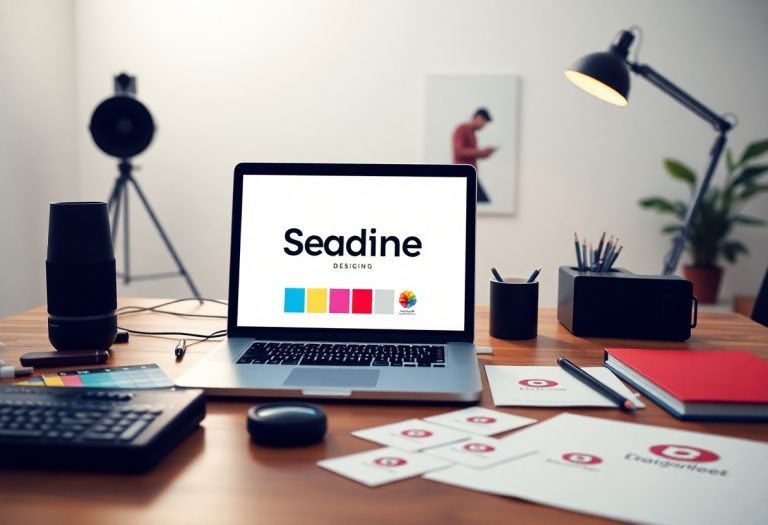Creating Branded Visual Content for Social Media Marketing
Marketing your brand effectively on social media hinges on the visual content you create. By understanding the significance of cohesive and appealing visuals, you can elevate your brand’s presence and engage your audience more effectively. This post explores key strategies for designing branded visuals that capture attention and communicate your message clearly. You’ll discover practical tips and tools to enhance your social media marketing efforts.
Understanding Branded Visual Content
Branded visual content encompasses imagery, videos, and graphics that reflect your brand’s identity and message. These visuals serve as immediate touchpoints for your audience, communicating your values, tone, and overall aesthetic without the need for text. Incorporating consistent branding elements—such as colors, fonts, and logos—enhances recognition and builds trust with viewers, ensuring that your content stands out in crowded social feeds.
Importance of Visuals in Social Media
Visual content is a powerful tool in social media marketing because it captures attention more effectively than text alone. Posts with images get 650% more engagement than those without, making visuals imperative for maximizing reach. Eye-catching visuals not only attract likes and shares but also foster emotional connections, prompting audiences to remember your brand and message long after scrolling has ended.
Elements of Effective Branding
Effective branding includes consistent visual identity, emotion-driven messaging, and a defined target audience. By choosing colors that evoke specific feelings or utilizing fonts that resonate with your personality, you create a cohesive image. Consistency across all platforms builds familiarity, which results in loyalty. Engaging narratives that reflect your audience’s aspirations further propel your brand’s image, making it more relatable and memorable.
To enhance your branding, prioritize elements that reflect your company’s values. For instance, a sustainable brand may use earthy tones and nature-inspired imagery to reinforce its commitment to the environment. Additionally, ensure that your logo is prominently featured in all graphics to strengthen recognition. Research shows that brands with consistent messaging are 3 to 4 times more likely to enjoy brand visibility. Analyzing your audience’s preferences will also help you tailor your visuals to their interests, increasing engagement and building a stronger connection with your community.
Types of Visual Content for Social Media
Visual content is crucial for capturing attention and engaging your audience on social media. Each type serves a unique purpose and can drastically affect your brand’s visibility. Depending on your marketing goals, you may want to explore various formats to connect with your target audience effectively.
- Images and Photography
- Videos and Animations
- Infographics
- Stories and Reels
- Live Streams
Recognizing the strengths of each type helps you craft a diverse visual content strategy that resonates with your followers.
| Type of Content | Description |
|---|---|
| Images | High-quality photos that showcase your products or brand personality. |
| Videos | Engaging clips that tell a story or demonstrate a product’s features. |
| Infographics | Visual representations of data that simplify complex information. |
| Stories | Ephemeral content designed for quick, relatable engagement. |
| Live Streams | Real-time video sessions that foster direct interaction with your audience. |
Images and Photography
Images and photography are your primary tools for visual storytelling. High-resolution images that reflect your brand’s values and aesthetic can create an instant connection with your audience. Utilize user-generated content, lifestyle images, or product-focused shots to maintain authenticity and showcase the experiences your brand offers. Effective visuals often lead to a significant increase in engagement metrics.
Videos and Animations
Videos and animations often outperform static images when it comes to engagement. Short, captivating videos can convey messages quickly and effectively, holding the viewer’s attention for longer periods. Incorporating animations can also add a layer of creativity and fun, especially for explainer videos or tutorials. Brands that leverage video advertising typically see a boost in conversion rates, emphasizing its power in social media marketing.
Platforms like Instagram, TikTok, and Facebook heavily favor video content, making it crucial for maximizing your reach. Many brands utilize these formats for storytelling, behind-the-scenes glimpses, or showcasing testimonials. The trend for vertical videos continues to rise, appealing to mobile users. In fact, including a video on a landing page can increase conversions by up to 80%. Tailoring your videos to fit platform specifications allows you to engage your audience effectively and encourages shares that expand your reach organically.
Designing Compelling Visuals
Visuals should not only capture attention but also resonate with your brand ethos. Creating images that reflect your brand’s personality can enhance engagement and influence your audience’s perception. Pay close attention to color palettes, typography, and imagery that thrive within your niche, ensuring consistency across all platforms. Strive for visuals that tell a story or evoke an emotion, making them more shareable and memorable.
Tools and Software for Creation
Utilize accessible tools like Canva, Adobe Spark, or Piktochart to streamline your design process. Each offers intuitive interfaces and customizable templates tailored for social media. For more advanced users, Adobe Creative Suite, including Photoshop and Illustrator, provides extensive capabilities to create one-of-a-kind visuals. Explore these options based on your skill level and specific project needs.
Best Practices for Design
Adhering to best practices in design enhances the effectiveness of your visuals. For instance, maintain a balance between imagery and text to create a clear focus. Using high-resolution images (at least 1080 x 1080 pixels for Instagram) ensures professionalism and clarity. Consistency in branding elements like logos and color schemes across different posts reinforces brand identity. Think about your audience’s viewing habits; for mobile users, design visuals that are easily readable at a glance, optimizing for smaller screens.
Incorporating white space effectively can make your design look more polished and professional. Use contrasting colors to highlight key information or calls-to-action, ensuring they stand out on crowded feeds. Regularly analyze engagement metrics for your visuals to identify which styles resonate most with your audience, allowing you to refine your approach over time. Experiment with motion graphics or short videos, as dynamic content tends to increase engagement rates significantly, capturing attention more effectively than static images alone.
Tailoring Visual Content for Different Platforms
Each social media platform has its unique characteristics that require tailored visual content. Crafting visuals specifically designed for platforms such as Facebook, Instagram, Twitter, and LinkedIn increases engagement and enhances brand recognition. Understanding the dimensions, user behaviors, and content preferences of each platform helps you create impactful visuals that resonate with your audience.
Facebook and Instagram Strategies
Facebook and Instagram thrive on high-quality images and videos. Utilize vibrant colors and clear branding to attract users’ attention. Stories on Instagram are an effective way to engage viewers with behind-the-scenes content, while Facebook posts can incorporate carousel ads to showcase multiple products or stories, maximizing engagement and driving traffic to your site.
Twitter and LinkedIn Visuals
Visuals on Twitter and LinkedIn require a different approach due to their user demographics and content consumption habits. Images that convey messages succinctly can boost share rates on Twitter, while LinkedIn demands professional visuals, such as infographics, that align with industry insights.
On Twitter, incorporating eye-catching graphics or short videos can help your tweets stand out in a fast-paced feed; studies show that tweets with images receive 150% more retweets than text-only tweets. For LinkedIn, infographics narrating industry trends or statistics can position you as a thought leader, driving engagement among professionals seeking valuable content. Tailoring your visuals to these platforms’ distinct audiences enhances your content’s relevance and effectiveness, leading to higher engagement rates and improved brand visibility.
Measuring the Impact of Visual Content
Understanding the effectiveness of your visual content is vital for optimizing your social media strategy. Assessing engagement levels, reach, and conversions allows you to determine what resonates most with your audience. By continuously measuring these metrics, adjustments can be made to enhance content performance and achieve your marketing goals.
Key Metrics to Track
You should focus on key metrics such as engagement rate, impressions, and click-through rate. Engagement rate indicates how well your audience interacts with your visuals, while impressions reveal how many times your content is displayed. Monitoring click-through rates shows how many users took action, providing insight into content effectiveness and audience interest.
Tools for Analytics
Analytics tools streamline the process of measuring the performance of your visual content. Platforms like Google Analytics, Hootsuite, and Sprout Social can offer in-depth insights into user behavior and content performance across different networks, helping you make data-driven decisions.
Google Analytics provides comprehensive data on user interactions on your website, showcasing how social media visual content drives traffic and conversions. Hootsuite’s reporting features enable you to track engagement levels in real time, while Sprout Social offers detailed audience demographics and post-performance metrics. Utilizing these tools helps refine your strategy and increase overall campaign effectiveness, ensuring your visual content achieves its intended purpose.
Case Studies of Successful Branded Visual Content
Analyzing successful case studies can provide invaluable insights into effective branded visual content strategies. Companies like Airbnb, Nike, and Coca-Cola have leveraged stunning imagery and cohesive branding to enhance engagement and drive conversions. For example, Airbnb’s user-generated content campaign led to a 20% increase in bookings, while Nike’s visually-driven Instagram stories resulted in a 30% uptick in follower engagement. Coca-Cola’s “Share a Coke” campaign saw a 500% increase in social media mentions, illustrating the power of personalized visual content.
- Airbnb: 20% increase in bookings via user-generated imagery.
- Nike: 30% increase in follower engagement through Instagram stories.
- Coca-Cola: 500% increase in social media mentions with personalized labels.
- Starbucks: 79% growth in Instagram followers with visually appealing seasonal promotions.
- GoPro: 40% increase in user engagement by showcasing customer footage.
Industry Examples
The beauty and fashion industries excel in creating visually impactful content. For instance, Sephora employs innovative use of augmented reality through their app, allowing users to try on products virtually, which has led to a 30% increase in online sales. Similarly, fashion brands like Zara utilize visually striking social media feeds to boost awareness and capture consumer attention, resulting in a 25% rise in engagement metrics.
Lessons Learned
Key insights from these case studies highlight the importance of consistency, emotional connection, and user involvement in visual content creation. Utilizing strong brand visuals fosters recognition and loyalty, while engaging users through interactive elements or user-generated content amplifies reach and engagement. Aligning your visuals with your brand messaging effectively communicates your values, making your content more relatable.
Focusing on consistency in your visual identity—using specific color palettes, fonts, and styles—across various platforms reinforces brand recognition. Engaging users through interactive visuals, like polls or contests, invites participation, enhancing connection to your brand. Analyzing the emotional response your visuals invoke can guide your strategy; content that resonates emotionally tends to drive higher engagement rates. Ultimately, the lessons from these successful case studies emphasize adapting your visual content approach based on audience insights and measurable outcomes for sustained growth.
Conclusion
As a reminder, creating branded visual content is imperative for your social media marketing success. By defining your brand identity, utilizing appealing visuals, and maintaining consistency across platforms, you can effectively engage your audience and enhance brand recognition. Focus on creating high-quality, relevant content that resonates with your target demographic. Implement these strategies to elevate your online presence and achieve your marketing goals.






